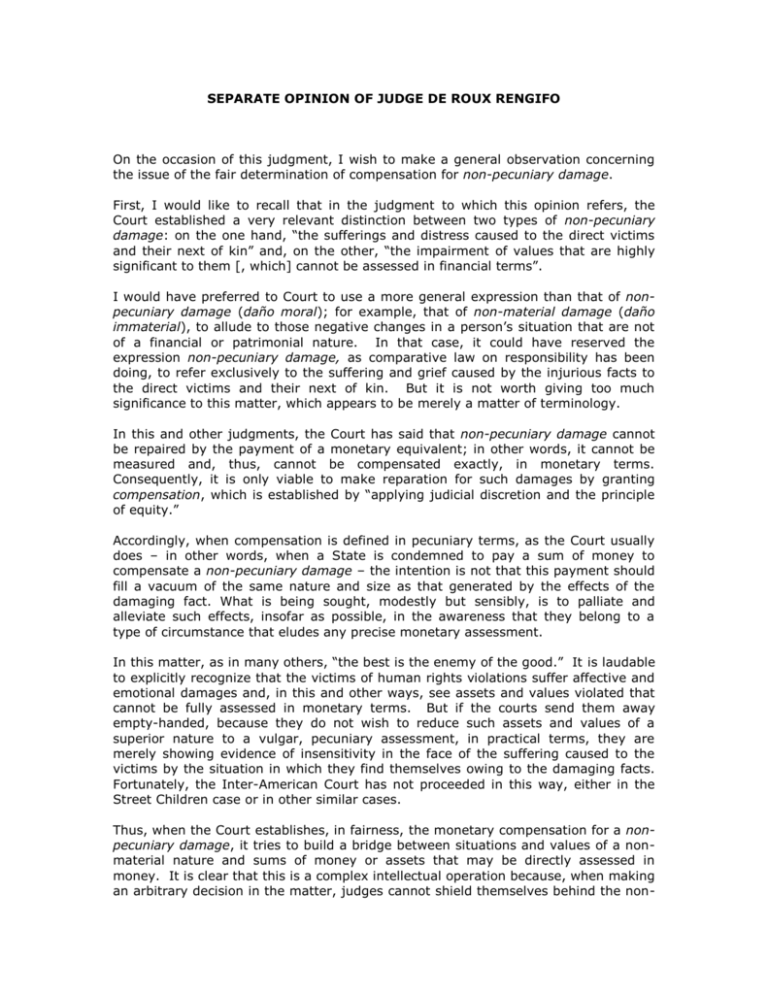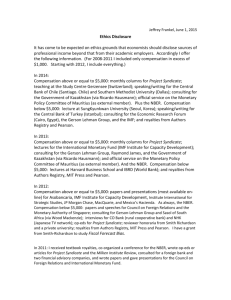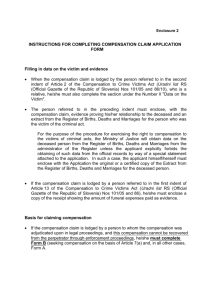INDICE DE TEMAS:
advertisement

SEPARATE OPINION OF JUDGE DE ROUX RENGIFO On the occasion of this judgment, I wish to make a general observation concerning the issue of the fair determination of compensation for non-pecuniary damage. First, I would like to recall that in the judgment to which this opinion refers, the Court established a very relevant distinction between two types of non-pecuniary damage: on the one hand, “the sufferings and distress caused to the direct victims and their next of kin” and, on the other, “the impairment of values that are highly significant to them [, which] cannot be assessed in financial terms”. I would have preferred to Court to use a more general expression than that of nonpecuniary damage (daño moral); for example, that of non-material damage (daño immaterial), to allude to those negative changes in a person’s situation that are not of a financial or patrimonial nature. In that case, it could have reserved the expression non-pecuniary damage, as comparative law on responsibility has been doing, to refer exclusively to the suffering and grief caused by the injurious facts to the direct victims and their next of kin. But it is not worth giving too much significance to this matter, which appears to be merely a matter of terminology. In this and other judgments, the Court has said that non-pecuniary damage cannot be repaired by the payment of a monetary equivalent; in other words, it cannot be measured and, thus, cannot be compensated exactly, in monetary terms. Consequently, it is only viable to make reparation for such damages by granting compensation, which is established by “applying judicial discretion and the principle of equity.” Accordingly, when compensation is defined in pecuniary terms, as the Court usually does – in other words, when a State is condemned to pay a sum of money to compensate a non-pecuniary damage – the intention is not that this payment should fill a vacuum of the same nature and size as that generated by the effects of the damaging fact. What is being sought, modestly but sensibly, is to palliate and alleviate such effects, insofar as possible, in the awareness that they belong to a type of circumstance that eludes any precise monetary assessment. In this matter, as in many others, “the best is the enemy of the good.” It is laudable to explicitly recognize that the victims of human rights violations suffer affective and emotional damages and, in this and other ways, see assets and values violated that cannot be fully assessed in monetary terms. But if the courts send them away empty-handed, because they do not wish to reduce such assets and values of a superior nature to a vulgar, pecuniary assessment, in practical terms, they are merely showing evidence of insensitivity in the face of the suffering caused to the victims by the situation in which they find themselves owing to the damaging facts. Fortunately, the Inter-American Court has not proceeded in this way, either in the Street Children case or in other similar cases. Thus, when the Court establishes, in fairness, the monetary compensation for a nonpecuniary damage, it tries to build a bridge between situations and values of a nonmaterial nature and sums of money or assets that may be directly assessed in money. It is clear that this is a complex intellectual operation because, when making an arbitrary decision in the matter, judges cannot shield themselves behind the non- 2 compatibility of the nature of these two types of circumstances that has to be taken into account. In the practice of the courts, the matter is handled as follows: starting with a certain amount (frequently suggested by reference to preceding decisions of the court in question or other similar courts), this is submitted to a sort of negative test in order to establish whether it appears inadequate, either because it is too much or too little. After the appropriate modifications are introduced, the figure that best weathers the said test is reached. The more precisely they trace the frontiers of each of the categories of conditions and values of an non-material nature that it is hoped to repair by determining, in fairness, a monetary compensation, the better these decisions are. As I have indicated above, distinctions, such as those made by the Inter-American Court in this case, between the grief and pain suffered by the direct victims and their next of kin and the impairment of certain values of a non-pecuniary nature that are very significant for the individual, help make the type of demarcation referred to in the previous paragraph. In the light of this distinction, we may speak of the following types of non-pecuniary damage in cases such as this one: 1. The mental and physical suffering undergone by the direct and indirect victims (real non-pecuniary damage), and 2. Other non-material damage, among which we may consider those indicated below: a) Loss of life, considered as an autonomous value*; b) Destruction of the life plan, when it is shown that, by constantly investing efforts and resources, the victims had constructed such a plan, and this was cut short by the human rights violations that constitute the facts of the case; c) Alteration of the emotional and affective living conditions that arise from the loss of a close relative; usually this is particularly serious in the case of children and extends in time far beyond the moment when the death of the loved one has ceased to cause perceptible grief. Three objections are usually made to the recognition of compensation for loss of life. First, due precisely to the fact that he died, the victim did not consciously suffer because of the deprivation of the asset in question. Disregarding the fact that this objection can only be made when death is instantaneous, it should be indicated that it is only valid if non-pecuniary damage is reduced to pain and suffering and we fail to consider that the loss of certain non-pecuniary or patrimonial assets, which do not necessarily produce that type of suffering, also correspond to this kind of damage. A second objection indicates that life is an asset that cannot be measured in monetary terms and that, by definition, the person who is deprived of his life cannot be the subject of any reparation. However, should this objection be successful, all the constructions of the law of responsibility relating to compensation for non-material damage would be destroyed because, as has been reiterated, it cannot be assessed in monetary terms. A third adverse comment is more pragmatic. It asserts that, if we admit reparation of life as an autonomous asset, we would be paving the way towards exorbitant penalties that would, in the final count, endanger the very survival of human rights protection systems. But an approach that attempts to close the way to excessive judgments, hiding something that is self-evident – that to kill a person is to deprive him of an asset, the asset of life, and cause him a damage that merits compensation – is not a reasonable way to approach this issue. * 3 The relevance of resorting to categories such as these is particularly evident in complex cases – those that involve the violation of various rights of many persons. In such an event, it is necessary to fine-tune the assessment of damage, in particular non-pecuniary damage, in order to be certain that compensations rigorously adapted to the particularities of each individual situation are ordered in favor of each victim. In the Street Children case, the Court performed the operation of assessing the nonpecuniary damage, en bloc, as it were. It dedicated one of its considering paragraphs to asserting the various types of non-pecuniary damage alleged by the victims’ representatives and the Commission (physical and mental suffering, loss of life as an autonomous value, destruction of the life plan, failure to protect minors...). Abstaining from pronouncing itself on each of these “aspects” of the damage in question, the Court proceeded to indicate that it would bear them in mind, “insofar as they are pertinent and respond to the particularities of each individual case”, in order to establish the amount of the respective compensatory payments. Finally, it determined the value of the latter, assessing them in amounts that are generally higher than those of the penalties imposed on States for reparation of non-pecuniary damage in cases previously decided by the Court. I also agree, en bloc, with the results of the Court’s assessment, although, as explained above, I would have preferred that the different categories of violations and impairments of a non-material nature that the facts of the case caused the victims had been dealt with and calculated separately. Carlos Vicente de Roux-Rengifo Judge Manuel E. Ventura-Robles Secretary





